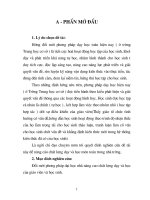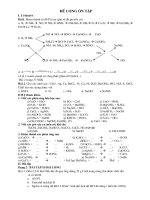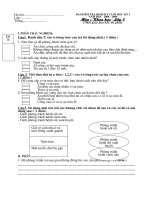tony hunt's structures notebook
Bạn đang xem bản rút gọn của tài liệu. Xem và tải ngay bản đầy đủ của tài liệu tại đây (2.17 MB, 113 trang )
Tony Hunt's Structures Notebook
This Page Intentionally Left Blank
Tony Hunt's Struttures Notebook
Tony
Hunt
Architectural Press
AMSTERDAM BOSTON HEIDELBERG LONDON NEW YORK OXFORD PARIS
SAN DIEGO SAN FRANCISCO SINGAPORE SYDNEY TOKYO
Architectural Press
An imprint of Elsevier
Linacre House, Jordan Hill, Oxford OX2 8DP
200 Wheeler Road, Burlington,
MA
01 803
First Edition 1997
Reprinted 1998
Second Edition 2003
Copyright
O
Tony Hunt, 2003. All rights reserved.
The right of Tony Hunt to be identified as the author of this work has been
asserted in accordance with the Copyright, Designs and Patent Act 1988.
No part of this publication may be reproduced in any material form (including
photocopying or storing in any medium by electronic means and whether or not
transiently or incidentally to some other use of this publication) without the written
permission of the copyright holder except in accordance with the provisions of the
Copyright, Designs and Patents Act 1988 or under the terms of a licence issued
by the Copyright Licensing Agency Ltd, 90 Tottenham Court Road, London,
England W1
T
4LP. Applications for the copyright holder's written permission to
reproduce any part of this publication should be addressed to the publishers.
Permissions may be sought directly from Elsevier's Science and Technology Rights
Department in Oxford,
UK:
phone: (+44) (0) 1865 843830; fax: (+44) (0) 1865
853333; e-mail:
You may also complete your request
on-line via the Elsevier homepage
(),
by selecting
'Customer Support' and then 'Obtaining Permissions'.
British Library Cataloguing in Publication Data
A catalogue record for this book
is
available from the British Library
ISBN 0 7506 5897 5
For information on all Architectural Press publications visit our website
at
www.architecturaIpress.com
rypeset, printed and bound in Great Britain
Contents
Prefoce to the First Edition
Prefoce to the Second Edition
Introduction
Structure and structural form
Structural materials
Loads on structure
Equilibrium
vii
ix
1
2
12
20
30
Structural elements and element behaviour
40
Structural types
50
Some further significant structures and assemblies
80
Appendix
I
Tensile strength of some common materials
Appendix
11
Bending and deflection formulae for beams
Appendix
Ill
Reading list
This Page Intentionally Left Blank
Preface to the First Edition
The Structures Notebook was originally written by Tony Hunt as a brief teaching aid for students at
the Royal College of
Art
who had very little,
if
any, knowledge of physics or structural behaviour.
The original Notebook was oversimplified but served its purpose as a primer. It has now been
expanded into a more comprehensive book while retaining
a
simple visual and non-mathematical
approach to structural behaviour.
The purpose of the Structures Notebook is to explain, in the simplest possible terms, about the
structure of 'things', and to demonstrate the fact that everything you see and touch, live in and
use, living and man-made, has a structure which
is
acted upon by natural forces and which
reacts to these forces according to its form and material.
The book is divided into seven main sections, in a logical sequence, and is written in simple
language. Each section, related to its text, contains a comprehensive set of hand-drawn sketches
which show, as simply as possible, what the text is about. The book is almost totally non-
mathematical, since the author believes very strongly that structural behaviour can be understood
best by diagrams and simple descriptions and that mathematics for the majority of people
interested in design is a barrier. The design of structures is a combination of art and science and
to achieve the best solution, concept should always come before calculation.
Professor Tony Hunt
vii
This Page Intentionally Left Blank
Preface to the Second Edition
Since this book
is
about the basics of structure and structural behaviour, both of which are
sub'ect to the laws of
ph
sics and mathematics, it
is
difficult to know what to add
~kis
book was first pu
C
lished in
1997.
The author feels that some key structurai ideas and
assemblies were not illustrated and they have now been included, together with some recent
examples. These expand the range of ideas conceived by different designers and show
further different ways of creatin
~nventive structures and structural assemblies. These illus-
8'
trations are included in a new C apter
8.
Recently, with some designers, there has been a move away from orthogonal geometries
to more random forms (see 'informal' by Cecil Balmond).
This
has been aided by the enor-
mous power of modern analytical and raphic computing, and has been driven by both
architects' and engineers' interest in exp
9
oring more complex geometries.
This
adds to the
complexity of desi n solutions and has to be considered as part of current design thinkin
3
a
I
Finally, the rea ing list has been added to for u -to-date references to books whic
consider to be important for architects, engineers an8designers.
Professor Tony Hunt
This Page Intentionally Left Blank
This book is about the basic structure of things.
Its aim is to develop an understanding of
essential structural principles and behaviour by
a descriptive and largely non-mathematical
approach. It relates to the structure occurring
in such diverse obiects as a bridge, a box for
packaging, furniture, buildings etc. and it
covers all the common structural elements
singly and in composite form.
This book is a primer on the subject. There
are a large number of books on building
structures, the most important or relevant of
which are listed in Appendix
Ill.
Structure and
structural form
Structure
What structure
is
Structure is the load-carrying part of all natural
and man-made forms.
It
is the part which
enables them to stand under their own weight
and under the worst conditions of externally
applied force.
The designer
In the context of structure, a designer is one
who conceives a structural part or a structural
system which functions satisfactorily,
is
integrated successfully within the overall design
and is appropriate for its purpose in terms of
material and form.
Structure
and
structural form
The design process
Without a brief it is not possible to design, since
there are no rules and no constraints.
Therefore, no matter how sketchy, it is the brief
which sets the basic framework for the designer.
It provides the lead-in for the first analysis of
the problem which then develops into an
iterative process, with ideas being tested,
modified, reiected, until an appropriate solution
to the problem is reached.
Optimum design
A designer should generally aim for the
optimum solution in order to obtain the maxi-
mum benefit with the minimum use of material
within the constraints of strength, stiffness
and stability. The result will be EFFICIENCY
combined ideally with ELEGANCE AND
ECONOMY.
Influences on the designer
The major influences on creative structural
design are:
Precedent
-
what's gone on
Awareness
-
what's going on
Practicality
-
how to do it
Tony Hunti Structures Notebook
Structural form
Structures take one of four basic forms which
may exist singly or in combination.
Solid An homogeneous mass structure
where the external surface
is independent of the internal
form
-
a three-dimensional solid
body
Surface An homogeneous surface where
the external and internal forms
are similar
-
a two-dimensional
panel
Skeletal
A framework where the assembly
of members gives a clear
indication of the form usually using
one-dimensional elements
Membrane
A
flexible sheet material
sometimes reinforced with linear
tension elements used either as
single cables or as a cable net.
A
variation
is
the pneumatic
where air under pressure is
contained by a tension
membrane skin
Hybrid
A
combination of two of the
above forms of near equal
dominance
For examples of all the above, see Chapter
7.
Structure and structural form
Tony Hunti Structures Notebook
Structural form in nature
Here are some examples of objects in nature,
all of
which
have a structure in one or more
forms:
Human and animal skeletons
Birds' wings
fish
flowers
Honeycombs
Leaves
Plants
Rock caves
Shellfish
Snails
Snowflakes
Spiders' webs
lrees
Structure and structural form
Tony Hunt? Structures Notebook
Structural form
-
man-made
Here are some examples of man-made
objects,
all
of which have
a
structure
in
one or
more forms:
Aeroplanes
Bicycles
Bridges
Buildings
Cars
Clothes
Cranes
Dams
Engines
Fabrics
Fastenings
Furniture
Musical instruments
Packaging
Pottery
Roads
Sculpture (3-D art)
Ships and
~achts
Sports gear
Technical instruments
Tents
Tools
Toys
Tunnels
Wheels
Structure and structural form
Tony Hunti Structures Notebook
Structure and structural form
Structural materials
All materials have a stiffness and strength and
are manufactured into a shape. Stiffness and
strength are different, complementary
characteristics and describe the properties of
a solid material. Shape affects performance.
Strength
Strength is the measure of the force required
to break the material.
A material can be strong or weak- see
Appendix
I.
Mild
steel
stiff and strong
Sheet
glass
stiff and weak
Nylon rope
flexible and strong
Rubber
flexible and weak
Structural materials
Stiffness
The majority of structural materials behave in
an elastic manner according to Hookers Law
which states that elastic extension is
proportional to load. When the load is
removed, the material recovers its original
length and shape.
Different materials have different stiffness
characteristics. They can be: stiff, flexible,
stretchy, springy or floppy.
This stiffness is defined for each material
as the E-value -Young's modulus, named
after its discoverer.
E
is the value of stress/strain and
is
a
constant for a given material.
Stiffness and strength do not necessarily go
hand in hand as the above examples show.
Tony Hunti Structures Notebook
Shape
Shape is the third property which affects the
performance of a material in a particular
loading situation. In pure tension, shape does
not matter, but in all other loading modes
-
compression, bending and shear
-
the cross-
sectional shape affects performance.
In general terms, for maximum perform-
ance, the material should be arranged in
order to be as far away from the centre of the
section as possible.
Material
behaviour
Materials are either 'isotropic' or 'anisotropic'
depending on their behaviour under load.
Isotropic
Providing equal performance
in all directions in both tension
and compression
Anisotropic
Providing differing perform-
ances in different directions
and in compression and
tension
Some examples:
Isotropic materials
Metals
Including steel, aluminium, bronze, titanium
etc.









